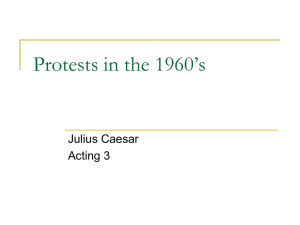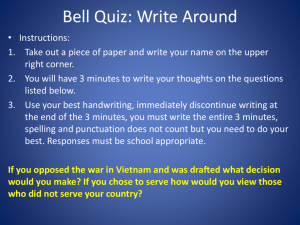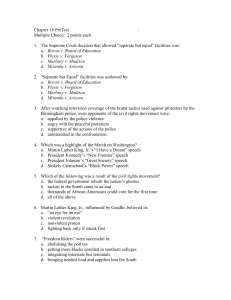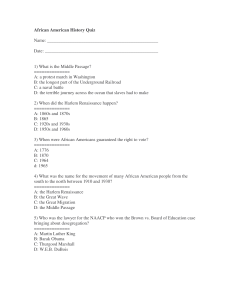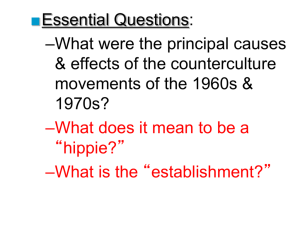Resistance - University of Warwick
advertisement
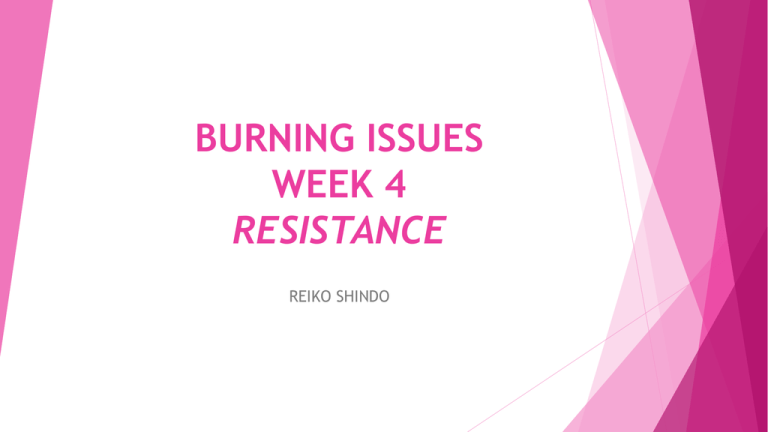
BURNING ISSUES WEEK 4 RESISTANCE REIKO SHINDO Introduction The purpose of MA Seminar Series – Introducing a range of key concepts to critically think about world politics (e.g. citizenship, community, resistance, sovereignty, language) Last week: Community – The limit of the concept of community? (Nationalism; alternative forms of community; the foreign-fighter phenomenon) This week What forms of resistance can we identify? What new practices can be understood as resistance? How is resistance discussed in IR? What is at stake in identifying particular practices as ‘resistance’ in IR? Resistance everywhere ! http://www.bbc.co.uk/news/world-africa-34636419 Students in South Africa protesting against university tuition fee increase, October 2015 Resistance everywhere! Protest to call for the immediate retrial of Royal Marine Sgt Alexander Blackman who was convicted of murdering a wounded Afghan insurgent, October 2015 Resistance everywhere! Asylum seekers sewing their lips and going on hunger strike in Australian-run asylum-seeker processing centre in Manus Island, January 2015 About 100 men detained in Harmondsworth Detention Centre (located just outside Heathrow Airport) protesting against the living condition in the centre, March 2015 Resistance everywhere! Nation-wide protest in response to the killing of an unarmed black teenager, Michael Brown, in the city of Ferguson, Missouri, by a white police officer, Darren Wilson, in 2014. Resistance everywhere! The ‘Umbrella Movement‘/ ‘Umbrella Revolution’ of 2014 in Hong Kong. Tens of thousands of people occupied major streets for nearly 3 months, protesting against Hong Kong’s electoral reform Resistance everywhere! Japanese youth group (SEALDs) and others protesting against the security bill introduced by the government, 2015 Resistance everywhere! The Occupy Wall Street Movement, 2011 Quick exercise! In pairs/groups, please discuss the following questions. What In examples of resistance can you come up with? List as many as you can! your opinion, which resistance is most important? Why? -The Occupy Wall Street Movement, 2011 USA On 17 September 2011, a group of people began a sit-in protest in Zuccotti Park, also known as Liberty Plaza Park, in the Financial District of New York. The collapse of the financial market and the economic crisis of 2008 led to a high unemployment rate in many countries. In America, the subsequent bailout of some major investment banks further fuelled the public sentiment that ‘99%’ of the people were victims of the ‘greed and corruption of the 1 %’. The aim of the protest was to express anger and frustration against the unregulated global financial market system. The purpose of the protest was to ‘fight back against the richest 1% of people that are writing the rules of an unfair global economy that is foreclosing on our future’ (http://occupywallst.org/). Location of the occupation, Wall Street, and its symbolic meaning as the centre of global economy ‘The key political tension in the coming era will be between the forces of neoliberal economic globalisation, seeking to expand the freedom of capital, and the forces of social resistance, seeking to preserve and to redefine community and solidarity’ (Gills 2000, 3). What is the most unique feature of the OWS movement? -The Occupy Wall Street Movement, 2011 USA- There were some practices of resistance organised outside the narrow confines of national boundaries prior to the late 1990s, before the term, ‘globalisation’ was invented. (e.g. Frantz Fanon, Ernesto ‘Che’ Guevara; movements such as the Non-Aligned Movement and the Organization of Front-Line States) ‘The politics of these [global] resistances has come to be floodlit by a broader set of connections to globalization and the oft-cited neoliberal restructuring strategies of states, multinational corporations and international organizations.’ (Amoore 2005: 4) Resistance before the term, ‘globalisation’ is invented… Anti-colonial struggles: practices to resist colonial oppression Resistance movements under occupation (e.g. people in China resisting the Japanese occupation in the 1930s and 40s; anti-Nazi resistance movements across European countries including France, Germany, Greece, Italy, and Norway) Museum of the War of Chinese People's Resistance Against Japanese Aggression -The Occupy Wall Street Movement, 2011 USA Resistance is associated with practices that unsettle the idea that the state is the main player in politics. Resistance offers scope to examine activities that are led by individuals and groups of people other than the state, take place within, across and beyond states, and are formulated around issues that are no longer confined to state boundaries. Together with phrases such as ‘global resistance’ and ‘transversal dissent’, there has been growing attention to political activism which ‘claim[s] maturity and legitimacy at the centres of political life.’ (Walker 1994: 669). Political activism in the age of globalisation is considered to be ‘transnational’ because individuals and groups mobilise resources available beyond national boundaries and use new tactics to communicate their messages (e.g. ‘boomerang pattern’ (Keck and Sikkink 1998) Other examples include: The Zapatistas movement in Chiapas, Mexico, antiWorld Trade Organisation (WTO) movements -The anti-nuclear protests after the 3.11 disaster 2011, Japan the Fukushima Daiichi nuclear power plant explosion triggered by the Great East Japan Earthquake of 11 March 2011 (the 3.11 disaster hereafter). A magnitude 9.0 earthquake hit the northern part of Japan, primarily, Miyagi, Iwate and Fukushima prefectures. About 15,000 people were killed and more than 2,000 were still missing as of 2015. The 3.11 disaster was a calamity incomparable to other disasters in Japan because of the nuclear power plant crisis caused by the earthquake and tsunami. The following few days of the earthquake witnessed explosions in reactors 1, 3 and 4 of the Fukushima Daiichi nuclear power plant caused by hydrogen build-up. As of March 2014, about 104,000 households still lived in temporary houses, and 84 percent of the temporary houses set up by the government in Iwate, Miyagi and Fukushima were occupied (Asahi Shimbun, 11 March 2014: 1). More than 260,000 people were still forced to live elsewhere; and about half of them originally came from Fukushima (Mainichi Shimbun, 11 March 2014: 1). -The anti-nuclear protests after the 3.11 disaster 2011, Japan The explosive growth of anti-nuclear demonstrations after the 3.11 disaster. Some of the anti-nuclear street demonstrations attracted more than 10, 000 people. One of the iconic anti-nuclear demonstrations was called ‘Stop Nukes Demonstration’ (Genpatsu Yamero Demo) held on 10 April 2011 in Koenji, Tokyo, which attracted 15,000 protesters. Since the government’s announcement to reactivate the Ooi nuclear power plant in June 2012, the regular demonstration which had been held every Friday in front of the Prime Minister’s residence since 29 March 2012, started to attract more than 10,000 people. Previously the number of its attendees was merely around 1000. On Friday June 29, 200,000 people surrounded the Prime Minister’s residence to challenge the reopening of the Ooi nuclear power plant. In subsequent months, this trend continued: 150,000 (on 6 July 2012), 90,000 (on 20 July 2012), 80,000 (August 3 2012), 90,000 (10 August 2012), 60,000 (17 August 2012, 2 June 2013), and 40,000 (24 and 31 August, 7 September, 2012) (Oguma 2013). (The number of demonstrators and the list of demonstrations after the 3.11 disaster are available from Oguma 2013) -The anti-nuclear protests after the 3.11 disaster 2011, Japan Do you think the anti-nuclear protest is different from the Occupy Wall Street? If yes, why? If not, how are they similar to each other? -The anti-nuclear protests after the 3.11 disaster 2011, Japan Demanding to the state to take actions on specific issues (in this case, nuclear energy policies) The survivors asserting their own part in deciding what it means to be safe and what issues should be regarded as ‘security’. They refuse to accept the claim that nuclear energy is safe: for them, the 3.11 disaster exposed the limit of the idea of security dependent on nuclear energy. They demand the state to create a different kind of a society, that is, a society free from the fear of risks associated with nuclear power plants. -Sudanese sit-in protest, 2005, Egypt(Moulin and Nyers (2007) ‘“We Live in a Country of UNCHR” Refugee Protest and Global Political Society’, International Political Sociology, 1 (4)) Between September and December 2005 over 3,000 Sudanese refugees held a sit-in demonstration at the Mustapha Mahmoud Square in Cairo, Egypt. The protesters are composed of both one-hundred Sudanese whose asylum applications are unsuccessful and three thousand Sudanese of varying degrees of status. The main target of the protest was the United Nations High Commissioner for Refugees, the UN agency, that handles the asylum process in Egypt. The location of the protest was symbolic (The UNHCR office in Egypt is located across the Mustapha Mahmoud Square). Their key demands include: being included in discussions about the politics of their status, the terms of their care and protection, and the future possibilities for international resettlement. The UNHCR refused to respond to the protesters’ demands, which eventually led to the Egyptian police and security forces using force to remove the protesters from the sit-in site. This resulted in hundreds of protesters being arrested and detained, 28 deaths, and numerous injuries. What aspect of the Sudanese sit-in protest is the most striking to you? Why? -Sudanese sit-in protest, 2005, Egypt The protesters bypassing the state and appealing directly to the international community (in this case, the UNHCR) Creating their own community which provides care and protection: neither the state (in this case, the Egyptian government) nor the international community (in this case, the UNHCR) managed to provide security and protection to the Sudanese demonstrators. Protests at micro-levels where certain types of political subjects are configured through power relations, as opposed to protests taking place at macro-levels, i.e. the level of the state and the state system. (e.g. Sudanese demonstrators asserted that they were ‘refugees’ and asserted that they had the legitimate place to speak despite their ‘illegal’ status). Thinking from this perspective, it is not sufficient to focus on practices that are aimed at liberating individuals or groups from organisations, such as the state and WTO, or the system which these institutions create and sustain, because policy changes and institutional reforms ‘leave certain forms and technologies of power firmly in place’ (Rygiel 2010: 37). -Sudanese sit-in protest, 2005, Egypt- Please discuss in pairs the following question. What other similar examples of resistance can you think of? In what way are they similar to the Sudanese sit-in protest? - ‘everyday forms of resistance’ (Scott 1985; see also Scott 1990) James Scott’s contention that there are two types of resistance: volitional and unintentional. The former (volitional resistance) refers to practices that are organised and self-sacrificial, bring about revolutionary consequences, and communicate ‘ideas or intentions that negate the basis of domination itself’ (Scott 1985: 292). The latter (unintentional resistance) refers to unplanned and individualistic practices that bring no revolutionary consequences because people do not wish to change the status quo (Scott 1985: 292) Volitional resistance include street demonstrations, occupying public spaces, strikes, sit-in demonstrations, hunger-strikes, and demonstrations which use various innovative methods to draw public attention. These protests are designed to declare and disseminate anger and frustrations about the status quo as widely as possible. A display of dissenting voices is vital for protesters to openly communicate their demands with others. Visible practices do not necessarily require words: they sometimes rely on means of communication other than words. - ‘everyday forms of resistance’ (Scott 1985; see also Scott 1990) Unintentional resistance refers to practices where the people engaged in resistance have no intention of risking retaliation to change the status quo. Unintentional resistance employ the tactics available in everyday situations. They are ‘the ordinary weapons of relatively powerless groups’ such as ‘foot dragging, dissimulation, desertion, false compliance, pilfering, feigned ignorance, slander, arson, sabotage’ (Scott 1985: xvi). Fearing retaliation, the oppressed is not willing to exhibit their opposition in an open manner. In this respect, everyday forms of resistance are in the ‘unobtrusive realm of political struggle’ (Scott 1990: 183). They are hidden from the eyes of the oppressors. The quotidian type of resistance is undetectable as ‘resistance’. There is no open declaration of dissent and expression of antagonism from the side of subordinate groups. Instead, they use tactics that evade open confrontation. What examples of ‘everyday forms of resistance’ can you think of? (e.g. the Anonymous cyber protesters, not showing their faces; the culture of political satires developed under the oppressed regimes) Before we finish the class… Reflection points: What practices are identified as ‘resistance’ in IR scholarship? What is at stake in identifying some practices as resistance and others not? International – domestic division (while practices that have ‘international dimension’ are often regarded as ‘resistance’, practices that have only ‘domestic’ implications are not. For instance, strikes.) Normative assumption (while practices that are developed around norms such as human rights, freedom of movement, environmental security, tend to be readily identified as ‘resistance’, others are not. For instance, think about a series of arsons in Germany in response to the current European migration crisis, they are expressing their dissident voices. So why not call that ‘resistance’? Summary Today we discussed different features attached to resistance. Resistance movements under colonial oppression / military occupation of other countries Protests which have emerged in the context of globalisation Demanding the state to take action on specific issues Resistance at the micro-level (outside the language of the state) Invisible forms of resistance The politics of naming some practices as ‘resistance’ (Resistance as a ‘derivative’ concept) Next week…. Recommended readings Brown, M. (1996) ‘On Resisting Resistance’, American Anthropologist 98 (4): 729-749. Guillaume, X. (2011) ‘Resistance and the International: The Challenge of the Everyday’, International Political Sociology 5 (4): 450-462. Keck, M. E. and Sikkink, K. (1998) Activists Beyond Borders: Advocacy Networks in International Politics, Ithaca and London: Cornell University Press. Maiguashca, Bice (2003) ‘Governance and Resistance in World Politics Introduction’, Review of International Studies, 29: 3-28. Moulin, C. and Nyers P. (2007) ‘“We Live in a Country of UNCHR” Refugee Protest and Global Political Society’, International Political Sociology, 1 (4): 356-372. Scott, J. (1985) Weapons of the Weak: Everyday Forms of Peasant resistance, New Haven and London: Yale University Press. Scott, J. (1990) Domination and the Arts of Resistance: Hidden Transcripts, New Haven and London: Yale University Press. Scott, J. (1993) Everyday Forms of Resistance, Yokohama: PRIME, International Peace Research Institute Meigaku. Shindo, R. (2016 forthcoming) in Ní Mhurchú, Aoileann. and Shindo, Reiko. (Eds) Critical Imaginations in International Relations, Oxon: Routledge. Tarrow, S. (1998) Power in Movement: Social Movements and Contentious Politics, Cambridge: Cambridge University Press.
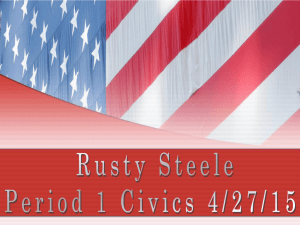
![The Politics of Protest [week 3]](http://s2.studylib.net/store/data/005229111_1-9491ac8e8d24cc184a2c9020ba192c97-300x300.png)
